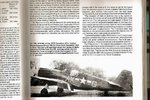Smokey Stover
Banned
Zero It had a reputation of being unbeatable but it never was and in the early days when it gained the reputation, it often fought second string fighters, not the latest. Hurricanes and P39's in particular.
RAF pilot Captain Eric 'Winkle' Brown evaluated a Zero at the A&AEE and said later of the aircraft "the Zero had ruled the roost totally and was the finest fighter in the world until mid-1943". It is a compelling irony that this invader from the land of the Rising Sun led to the twilight of the British Empire.
The illustration depicts the Mitsubishi A6M Model 22 (Although unlikely, most probably mistaken identity, as the A6M2 type 0 to 11 is more likely) 'White 13' of Feldwebel Heinz Bar 1./JG 51, September 1940. By this time Bar had scored 12 victories. His final total was 220 confirmed kills in over 1000 combat sorties.
Last edited:

